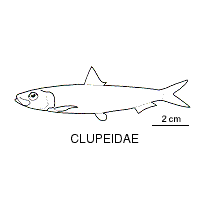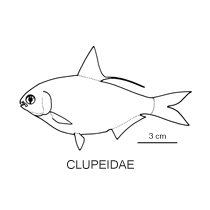- Classification
- ACTINOPTERYGII
- CLUPEIFORMES
- CLUPEIDAE
-
Fish Classification
-
Class
ACTINOPTERYGII Ray-finned fishes -
Order
CLUPEIFORMES Herrings -
Family
CLUPEIDAE Herrings
Family CLUPEIDAE
More Info
|
Family Taxonomy |
A large family of commercially important fishes found worldwide in tropical to cold-temperate seas, mostly in shallow-water habitats in marine, estuarine and freshwater environments. |
|
Family Distribution |
Sardines and relatives occur worldwide. They live mostly in surface marine waters, usually near the coast. Some species are estuarine and a few, like the Australian species of Nematolosa, are freshwater. |
|
Family Description |
Clupeids have a relatively small mouth with the jaw not extending behind the level of the eye, teeth usually small or absent and abdominal scutes usually present. |
|
Family Size |
Maximum standard length is about 60 cm,although most species are usually less than 20 cm. |
|
Family Feeding |
Mostly carnivores, feeding on zooplankton, especially small crustaceans. |
|
Family Commercial |
Commercially important throughout their range, and making up about half of the world's fish catch. Also an important food source for larger fishes, seabirds, and marine mammals. Relatively small numbers of freshly-caught fish are marketed in Australia. |
|
Family Remarks |
Most species form large schools for protection. |
|
Author |
Dianne J. Bray |
References
Lavoué S, Miya M, Musikasinthorn P, Chen WJ, Nishida M (2013) Mitogenomic evidence for an indo-west pacific origin of the clupeoidei (Teleostei: Clupeiformes). PLoS One 8:e56485
Munroe, T.A., Wongratana, T. & Nizinski, M.S. (1999). Family Clupeidae. pp. 1775–1821 in Carpenter, K.E. & Niem, V.H. (eds) The Living Marine Resources of the Western Central Pacific. FAO Species Identification Guide for Fisheries Purposes. Rome : FAO pp. 1397–2068
Nelson, G.J. (1970). The hypobranchial apparatus of teleostean fishes of the families Engraulidae and Chirocentridae. Am. Mus. Novit. 2410: 1–30 figs 1–11
Nelson, G.J. & Rothman, M.N. (1973). The species of gizzard shads (Dorosomatinae) with particular reference to the Indo-Pacific region. Bull. Am. Mus. Nat. Hist. 150(2): 133–206 figs 1–13
Nelson, J.S. (1994). Fishes of the World. New York : John Wiley & Sons 3rd Edn 600 pp.
Svetovidov, A.N. (1952). Fauna of U.S.S.R. Fishes. (Clupeidae). Zool. Inst. Akad. Nauk S.S.S.R. (ns 48)2(1): 1–331 figs 1–54 pls 1–53
Whitehead, P.J.P. (1973). A synopsis of the clupeoid fishes of India. J. Mar. Biol. Ass. India 14(1): 160–256 figs 1–68
Whitehead, P.J.P. (1985). FAO species catalog. Clupeoid fishes of the world (suborder Clupeoidei). Part 1 - Chirocentridae, Clupeidae and Pristigasteridae. FAO Fish. Synop., No. 125, volume 7 (part 1) pp. 1–303
Whitehead, P.J.P. & Bauchot, M.L. (1985). Catalogue critique des types de poissons du Muséum national d'Histoire Naturelle, (Suite) Ordre des Clupéiforms (Familles des Clupeidae, Engraulididae et Denticipitidae). Bull. Mus. Natl. Hist. Nat. Paris 7(4 Suppl.): 1–77
Whitehead, P.J.P., Boeseman, M. & Wheeler, A.C. (1966). The types of Bleeker's Indo-Pacific elopoid and clupeoid fishes. Zool. Verh. 84: 1–159 pls 1–19
Wongratana, T. (1983). Diagnoses of 24 new species and proposal of a new name for a species of Indo-Pacific clupeoid fishes. Jpn. J. Ichthyol. 29(4): 385–407 figs 1–25































































































